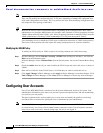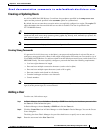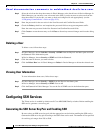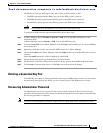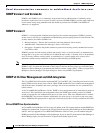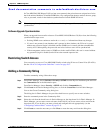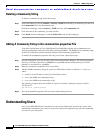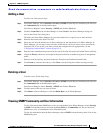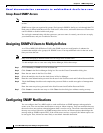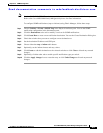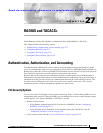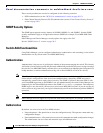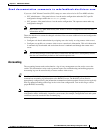
Send documentation comments to mdsfeedback-doc@cisco.com.
26-4
Cisco MDS 9000 Family Fabric Manager Configuration Guide
OL-6965-03, Cisco MDS SAN-OS Release 2.x
Chapter 26 SNMP Configuration
Understanding Users
Deleting a Community String
To delete a community string, follow these steps:
Step 1 From Fabric Manager, choose Switches > Security->SNMP from the Physical Attributes pane and click
the Communities tab in the Information pane.
From Device Manager, choose Security > SNMP and click the Communities tab.
Step 2 Click the name of the community you want to delete.
Step 3 Click Delete in Device Manager or click the Delete Row icon in Fabric Manager.
Adding A Community String to the communities.properties File
If you have a mixed fabric of Cisco SAN-OS and Cisco FabricWare switches, we recommend that you
securely open the fabric with a Cisco SAN-OS switch using SNMPv3. The SNMPv1/v2c community strings
for the Cisco FabricWare switches should be entered in the communities.properties file.
To modify the communities.properties file using a text editor, follow these steps:
Step 1 On your workstation, go to the directory where you installed Fabric Manager. The default installation
directory for Windows platforms is $HOME/cisco_mds9000/ and the default directory for UNIX
platforms is /usr/local/cisco_mds9000/.
Step 2 Open the communities.properties file in a text editor.
Step 3 Add the SNMP community strings for your Cisco FabricWare switches as ipaddress = read:write ,
where:
• ipaddress is the IP address of the Cisco FabricWare switch.
• read is the SNMP read community string.
• write is the SNMP write community string.
The following example shows the addition of a pair of read:write community strings for switch
192.168.10.12:
192.168.10.12 = public:private
Step 4 Save the communities.properties file and restart Fabric Manager Server.
Understanding Users
Every Cisco MDS 9000 Family switch user has the account information stored by the system. Your
authentication information, user name, user password, password expiration date, and role membership
are stored in your user profile.



